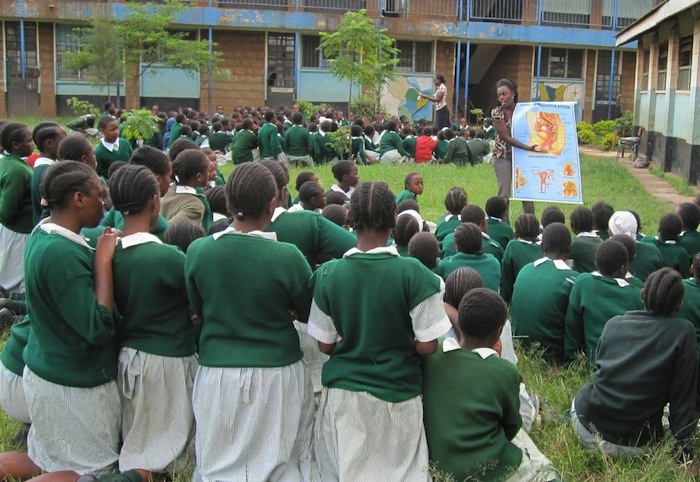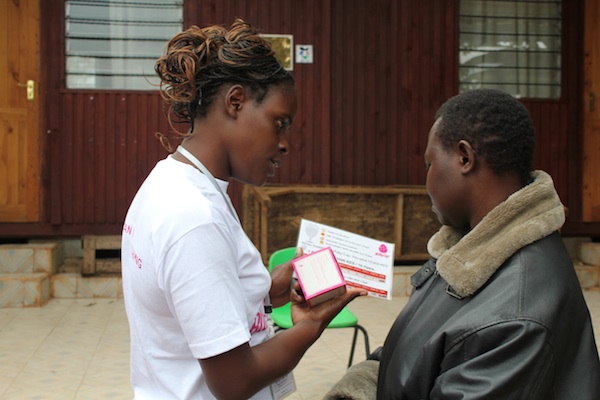A Delicate Balance for Ruby Cup: Improving public health, keeping girls in school through menstrual hygiene management
When health at the base of the pyramid comes to mind, most people typically think about issues like family planning, tuberculosis, malaria, diarrhea management, water purification, hunger, nutritional supplements and reading glasses. But little attention has been given to a problem that impacts billions of girls and women in low-income economies – menstrual hygiene management. Girls and women living at the BoP cannot afford tampons or pads, and as a result use unsanitary items like rags, cloth, socks and even bark and dried mud to manage their periods.
Perhaps worse, girls often stay out of school for fear of leaking because they lack appropriate menstrual hygiene management solutions. In Africa alone, WaterAid contends that up to 40 days may be missed, on average, by every African girl per school year due to menstruation. These missed days often mean that girls fall behind in their lessons and sometimes even drop out of school, limiting their future career options.
Like most, when Maxie Matthiessen thought about disadvantaged populations the first things that came to mind were food, toilets and shelter. But when she became aware of the menstrual hygiene management problem and was introduced to a low-cost, sustainable solution with a product lifetime of 10 years – the menstrual cup – she began thinking about how she could bring the solution to women and girls living in low-income economies. The result was an experiment in Kenya with a business model based on BoP theory.
The menstrual cup is worn inside the vagina during menstruation. Rather than absorbing the menstrual fluid as disposable products do, it collects it. When full, it is emptied, rinsed and applied again. To ensure hygienic use, the cup is boiled for five minutes and stored in a cotton bag between periods. In the development phase, Matthiessen and her team called their product and their company Ruby Cup. The word “Ruby” was used to brand the menstrual cycle as something valuable, not something that women should be ashamed of. After naming their organization, the team registered it as a limited liability company in Denmark and later in Nairobi.
We asked Matthiessen, chief operating officer of Ruby Cup, via e-mail to talk about the challenges, successes and failures Ruby Cup experienced in Kenya and how the company’s business model has evolved. (Editor’s note: Check out the GlobaLens case study, “A Delicate Balance for Ruby Cup: Profitability and Sustainability at the Base of the Pyramid.” GlobaLens is the publishing division of the William Davidson Institute. WDI is the parent organization of NextBillion.)
Mary Lowe: Talk about how you first began to consider the impact menstruation has on disadvantaged populations and how your concern for these populations led to the creation of Ruby Cup.
 Maxie Matthiessen (pictured left): When I was 14 years old and living in a small village in Northern Germany, I remember that my neighbors knocked on the door to collect donations for refugees in Southeast Asia. Among the things they collected were sanitary pads because there was a shortage of pads in this particular setting. That was the first time I realized that menstruation can be a very uncomfortable fact of life if you lack the money to buy feminine hygiene products. Fast forward 10 years, I started to learn about the menstrual cup – a product for menstruation made out of medical grade silicone that can be re-used for 10 years. So I put two and two together and thought that this product could be the solution in refugee or low-income settings where girls and women could not afford feminine hygiene products.
Maxie Matthiessen (pictured left): When I was 14 years old and living in a small village in Northern Germany, I remember that my neighbors knocked on the door to collect donations for refugees in Southeast Asia. Among the things they collected were sanitary pads because there was a shortage of pads in this particular setting. That was the first time I realized that menstruation can be a very uncomfortable fact of life if you lack the money to buy feminine hygiene products. Fast forward 10 years, I started to learn about the menstrual cup – a product for menstruation made out of medical grade silicone that can be re-used for 10 years. So I put two and two together and thought that this product could be the solution in refugee or low-income settings where girls and women could not afford feminine hygiene products.
ML: What challenges do girls and women at the BoP face due to a lack of menstrual hygiene management solutions?
MM: Billions of girls and women at the BoP and globally face challenges when dealing with their menstruation because most are unable to afford pads or tampons. As a result, they use unhygienic and unsafe materials such as rags, old newspaper, dried mud or pieces of mattresses. Consequently, some suffer from genital infections. Instead of attending school, they are also afraid of leaking and stay home one week a month or 20 percent of their school time. Menstruation is one of the main barriers that keeps girls out of school.
ML: How does the Ruby Cup resolve these challenges?
MM: Because the Ruby Cup lasts 10 years and is a very hygienic and water-efficient menstrual hygiene product, making this product available would mean that girls could go to school without worrying about their menstruation. They could go all the way from primary school to university without having to worry about their periods. That way, Ruby Cup would help girls stay in school.
ML: What marketing, pricing and distribution challenges did you face as you launched your business in Kenya?
MM: We tried to sell the product at prices ranging from 3 USD-10 USD, testing various distribution and direct sales models. One of the problems we encountered was that although demand for the product was high, women and girls were simply unable to afford the product. For a comparison, one pack of pads that lasts a maximum of one period costs around 1 USD. The Ruby Cup lasts 10 years and constitutes at least 95 percent cost savings over the course of 10 years. In other words, instead of spending 120 USD or more on pads or tampons over the course of 10 years, Ruby Cup would have cost 3 USD-5 USD over the same time span. The problem was that girls and women faced challenges paying the up-front 3 USD-5 USD. Also, when we tried to work with installment payment plans, it drove up operational expenses immensely, resulting in an increase in the cost of the product. Lastly, if girls and women are unable to afford 1 USD for sanitary pads and they are used to paying nothing, and use rags, old newspaper or cloth instead, how would you get these girls and women to spend 3 USD if they can spend the money on food instead?

Above: Kenyan schoolgirls learn about the Ruby Cup.
ML: What lessons did you learn and what advice would you give others seeking to build a business based on BoP theory?
MM: The key learning for me was that it is very difficult to build a profitable business with a durable consumer good when targeting the BoP. Because margins have to be kept low, BoP business only makes sense when you sell a fast-moving consumer good, so that the initial customer acquisition and marketing costs can be covered through high customer retention rates, and consequently repeat sales. Moreover, from a company perspective, it is very difficult to sell sustainable products in low-income markets because they are usually more expensive in up-front costs, and, from the consumer perspective, it is very difficult to afford these up-front costs although they usually mean cost savings in the long term. Basically, one has to be rich to be green and be able to afford durable or sustainable products. This is unfortunate since reaching sustainable development in BoP markets can only be achieved if companies start selling sustainable and durable products. But who helps low-income customers finance these products? Or, taking the meta-perspective, who finances the sustainable development of BoP markets? Do we have to leave this to the poor and the market only as BoP theory suggests, or is there room for state and public financing?
ML: How has the business been financed thus far?
MM: Ruby Cup has been financed through a combination of personal savings, grants, prize money from competitions and venture capital.
ML: Do you have a timetable for reaching profitability?
MM: Since we shifted the company focus and changed the target market from the BoP to high-end markets, we have been able to finance ourselves through income from sales. We are already a profitable business that operates mainly in Europe with a social mission to keep African girls in school. In contrast to the prior strategy and the market-based approach suggested in BoP literature, we now employ a philanthropic donation-based approach. For every Ruby Cup sold in, for example, Germany, we donate one to a girl in Kenya.

ML: How did you come to the decision to leverage the buy-one/give-one strategy?
MM: We had to make the decision to either die a slow financial death or radically rethink our business model. We just were not making money from selling Ruby Cups in Africa. We could either have established an NGO financed through grants and be dependent on external donors, or try to make money elsewhere, enabling us to pursue our mission of keeping underprivileged girls in school. We decided to keep the business-based approach, but with a different target market.
ML: Was it difficult to leave the BoP as a market for middle- and high-income customers?
MM: It was a very difficult decision because we started the business precisely with the idea to create development and to do good on market-based terms. By then, so much aid had failed, and we had a vision to make a difference in the world through social entrepreneurship and the BoP approach. Changing this vision was a bold step because it meant that we had to realize that what we had believed in – the BoP approach – was not working in our case, or in the case of durable consumer goods. Now we are back to the classic donation-based approach. Fortunately, this is working very well. It has to be noted that the distribution of the Ruby Cup is not market-distorting – for example, destroying local markets through donations, as might be the case with other donated products like garments – because there are no other cup brands on the market. We were able to distribute over 5,000 Ruby Cups in 2014 and will distribute another 10,000 in 2015. The feedback has been very positive, the adoption rate is high and soon we will be able to monitor if school attendance has increased.
ML: How is it going so far in this new market?
MM: The menstrual cup is gaining in popularity worldwide and since we started to target high-end markets through our buy-one/give-one business model, we have seen a 100 percent increase in sales each year. We keep our fingers crossed that this rate will continue because the more Ruby Cups we sell on the Internet, the more Ruby Cups we can provide to girls in need.
Mary Lowe is a research associate at the William Davidson Institute.
- Categories
- Education, Health Care
